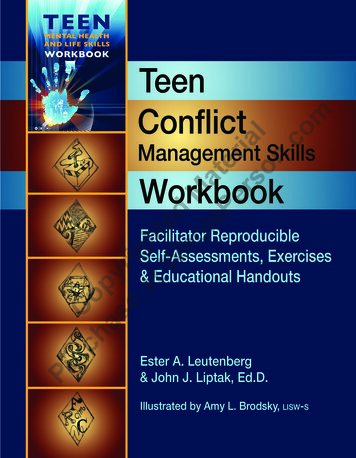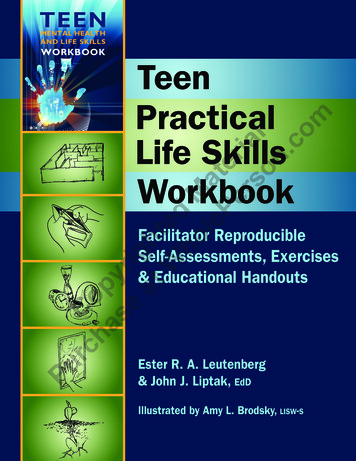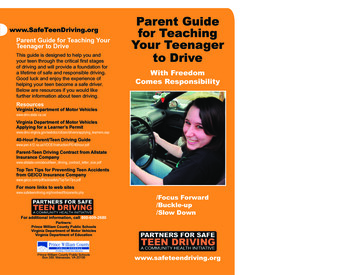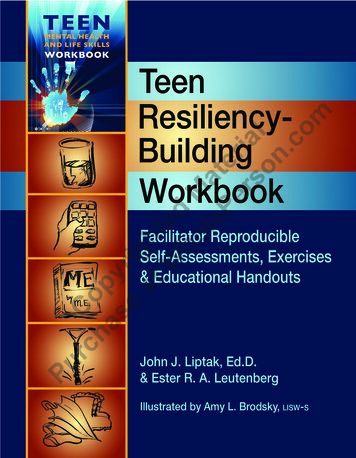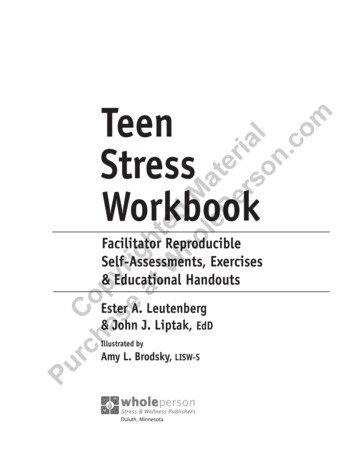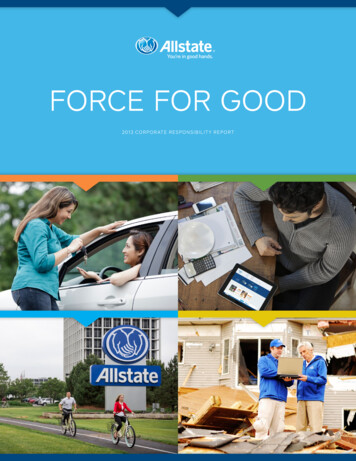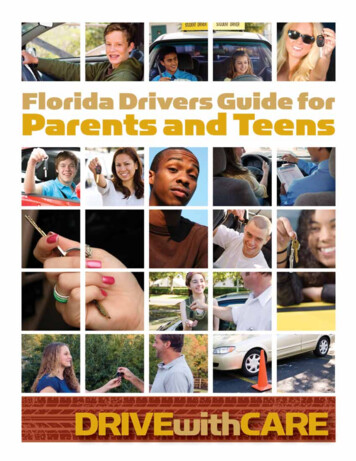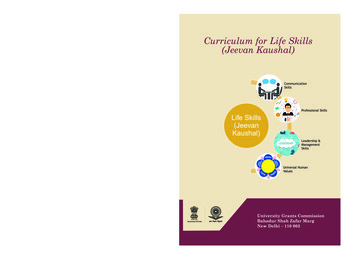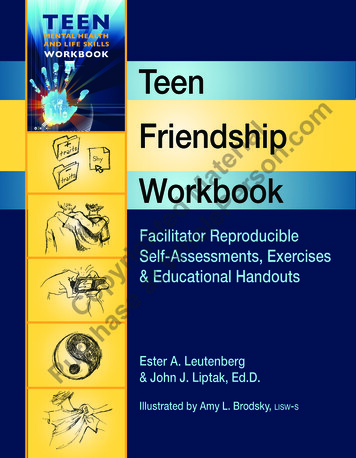
Transcription
TEENMENTAL HEALTHAND LIFE SKILLSWORKBOOKTeenCch oas pye rigat hW tedho Mle atPe errs acilitator ReproducibleFacilitator ReproducibleSelf-Assessments, ExercisesSelf-Assessments,Exercises& EducationalHandouts& Educational HandoutsEster A. LeutenbergJohn J. Liptak, EdDIllustrated byPurAmy L. Brodsky, LISW-SEster A. Leutenberg& John J. Liptak, Ed.D.Illustrated by Amy L. Brodsky, lisw-sDuluth, Minnesota
Cch oas pye rigat hW tedho Mle atPe errs ialon.com101 W. 2nd St., Suite 203Duluth MN son.comTeen Friendship WorkbookFacilitator Reproducible Self-Assessments,Exercises & Educational HandoutsCopyright 2011 by Ester A. Leutenberg and John J. Liptak.All rights reserved. Except for short excerpts for review purposesand materials in the assessment, journaling activities, andeducational handouts sections, no part of this book may bereproduced or transmitted in any form by any means, electronicor mechanical without permission in writing from the publisher.Self-assessments, exercises, and educational handouts are meantto be photocopied.All efforts have been made to ensure accuracy of the informationcontained in this book as of the date published. The author(s)and the publisher expressly disclaim responsibility for anyadverse effects arising from the use or application of theinformation contained herein.Printed in the United States of America10 9 8 7 6 5 4 3 2 1PurEditorial Director: Carlene SippolaArt Director: Joy Morgan DeyLibrary of Congress Control Number: 2010937661ISBN: 978-1-57025-249-5
Using This Book(For the professional)Cch oas pye rigat hW tedho Mle atPe errs ialon.comTeenagers choosing healthy friendships is of monumental importance! As childrenenter middle school and high school, they will be experiencing changes in friends,personal style, social life, movies, music, emotions, etc., in fact in all aspects of theirlives. They will also meet new friends who are experiencing these same changes.Teens want to spend more time with friends of their own age without supervision.With peers they can feel independent and connected as they develop and experienceidentities of their own. They will challenge authority, unable to see the value ofadvice from parents or other adults.Peer pressure, positive or negative, directs their choices and decisions. The thoughtsand actions of peers usually carry more weight than those from parents or otheradults. Teenagers may question their family and/or household’s rules and values.Friends can be a positive force for teens. As people mature, they choose friendswho share their tastes and values. Good friends influence each other to keep soundvalues. They will talk each other out of, rather than into, troublesome situations.Positive role modeling in friends affects social behaviors, understandingand acceptance.Teenagers’ social circle may have different thoughts on what’s okay and acceptable.Going along with the crowd may be “cool”, even though it may involve disobeyingparents, not doing schoolwork, risk-taking, and/or keeping up with their friends’material values.Teenagers who have friends that engage in problem behavior, delinquency,substance abuse, violence, are much more likely to behave the same way. Negativerole modeling in friends will influence and encourage poor judgment, bad habits,risky, and possibly illegal behavior. The Teen Friendship Workbook will serve as aguide to assist teens in choosing their friends wisely, thus avoiding potentially riskysituations. Being able to say “no” and not be negatively influenced by peers is one ofthe goals of this book.PurChoice of friends can make a huge difference. Healthy friendships are full of joy,fun, caring, empathy and mutual support. Friendships grow with time and requirea variety of skills that often need to be developed. The goal of this workbook is tohelp participants explore the skills they are using in their friendships. It incorporatesinteresting and eye-opening assessments to encourage participants to explore theirown personal friendship behavior, as well as that of their friends.(Continued)
Using This Book(For the professional, continued)Cch oas pye rigat hW tedho Mle atPe errs ialon.comThe Teen Friendship Workbook contains five separate sections to help teens learn moreabout themselves and the skills that are fundamental to developing and maintaining healthyfriendships. Participating in these exercises will help teens discover and better understandthe importance of these skills to live in harmony with a friend or a set of friends.SECTIONS OF THIS BOOKCharacteristics of Friends Scalehelps teens explore the types of positive and negative qualities their friends possess.Friendship Skills Scalehelps teens identify the strengths and weakness they possess in interacting with theirfriends.Friend Communication Skills Scalehelps teens identify and explore how well they are communicating with their friendsand develop better friendship communication skills.Friendship Personality Scalehelps teens understand their own personality and the personality of their friends tobetter accept each another for the ways they are different.Peer Pressure Scalehelps teens identify the ways in which they feel pressured or influenced by theirfriends to do things they may or may not want to do.By combining reflective assessment and journaling, participants will be exposed to apowerful method of combining verbalizing and writing to reflect on and solve problems.Participants will become more aware of the strengths and weaknesses of their specificrelationship and friendship-building skills.PurPreparation for using the assessments and activities in this book is important. The authorssuggest that prior to administering any of the assessments in this book, you completethem yourself. (Think back to your teen years.) Working on each assessment yourself willfamiliarize you with the format of the assessments, the scoring directions, the interpretationguides and the journaling activities. Although the assessments are designed to be selfadministered, scored and interpreted, this familiarity will help prepare facilitators to answerquestions participants might ask about the assessments.
The Assessments, Journaling Activitiesand Educational HandoutsCch oas pye rigat hW tedho Mle atPe errs ialon.comThe Assessments, Journaling Activities, and Educational Handouts in The Teen FriendshipWorkbook are reproducible and ready to be photocopied for participants’ use. Assessmentscontained in this book focus on self-reported. Accuracy and usefulness of the informationprovided depends on the truthful information that each participant provides through selfexamination. By being honest, participants help themselves to learn about unproductive andineffective friendship patterns, and to uncover information that might be keeping them frombeing as happy and/or as successful in friendships as they might be.Advise the teens using the assessments that they should not spend too much time trying toanalyze the content of the questions; their initial response will most likely be true. Regardlessof individual scores, encourage participants to write and talk about their findings and theirfeelings pertaining to what they have discovered about themselves. Exploring teen friendshipexercises will be helpful to the teens now and as they mature into adulthood.Use Codes for ConfidentialityConfidentiality is a term for any action that preserves the privacy of other people.Because the teens completing the activities in this workbook will be asked toanswer assessment items and to journal about and explore their relationshipswith their friends, you will need to discuss confidentiality before you begin usingthe materials in this workbook. Maintaining confidentiality is important as itshows respect for others and allows the participants to explore their feelingswithout hurting anyone’s feelings or fearing gossip, harm or retribution.PurIn order to maintain confidentiality, explain to the participants that they need toassign a code name for each person they write about as they complete the variousactivities in the workbook. For example, a friend named Joey who enjoys going tohockey games might be titled JHG (Joey Hockey Games) for a particular exercise.In order to protect their friends’ identities, they may not use people’s actual namesor initials – just codes.Thanks to the following whose input in this book has been so valuable!Teva Belle KaplanLucy Ritzic, OTR/LJay LeutenbergEileen Regen, M.Ed., CJEKathy Liptak, Ed.D.
Layout of the BookThis book includes the following reproducibles in all 5 sections:Cch oas pye rigat hW tedho Mle atPe errs ialon.com Assessment Instruments – Self-assessment inventories with scoring directions andinterpretation materials. Group facilitators can choose one or more of the activitiesrelevant to their participants. Activity Handouts – Practical questions and activities that prompt self-reflection andpromote self-understanding. These questions and activities foster introspection andpromote pro-social behaviors. Reflective Questions for Journaling – Self-exploration activities and journalingexercises specific to each assessment to enhance self-discovery, learning, and healing. Educational Handouts – Handouts designed to supplement instruction can beused individually or in groups. They can be distributed and converted into mastersfor individual copies, transparencies for overheads, scanned for other digitalpresentations or written down on a board and discussed.Who should use this program?This book has been designed as a practical tool for helping professional therapists,counselors, marriage and family therapists, psychologists, teachers, group leaders, etc.Depending on the role of the professional using The Teen Friendship Workbook and thespecific group’s needs, the sections can be used individually, combined, or implemented aspart of an integrated curriculum for a more comprehensive approach.Why use self-assessments?Self-assessments are important in teaching various life skills. Participants will . . .Become aware of the primary motivators that guide behavior.Explore and learn to indentify potentially harmful situations.Explore the effects of messages received in childhood.Gain insight that will guide behavioral change.Focus thinking on behavioral goals for change.Uncover resources that can help to cope with problems and difficulties.Identify personal characteristics without judgment.Develop full awareness of personal strengths and weaknesses.Pur Because the assessments are presented in a straightforward and easy-to-useformat, individuals can self-administer, score, and interpret each assessmentindependently.
Introduction for the ParticipantCch oas pye rigat hW tedho Mle atPe errs ialon.comYou and your friends can influence each other in positive and negative ways; your choice offriends is important. By choosing wisely, you and your friends will benefit from your eachother. One of the most important aspects in building your friendships is that you always needto be yourself – and true to yourself. You do not need to change who you are, nor shouldyour friends expect you to change for them.Before you make new friends, or evaluate your present friends, it helps to know what kindof person you want as your friend. It helps to have friends who like to do the same type ofthings you do and who share the same values that you do. That doesn't mean you have to beexactly like each other, just that you enjoy some of the same things. Sports, books and musicare some examples of activities that might be good to have in common. Values might bethe importance of family, honesty, good grades, being safe, etc. Without compromising, andsticking to your decisions by being true to yourself, you're bound to find and have friendswho are excited about the same things that excite and interest you.Your friendships may be changing because you and your friends are changing. Teenage yearsare a time of physical, emotional, and social growth and change. These changes happenat different times, or at different speeds, for each person. You might not need to end oldfriendships, but these relationships may need to change. You may find that you don't haveas much in common with some friends as you used to. It's important to pay attention to yourfeelings, and to know what you enjoy doing. If your friends seem to be spending more timein actions and activities that you don't enjoy, you might benefit by finding some new friendswho share your interests.Choosing and being a good friend definitely requires a set of skills you can use throughoutyour life. The Teen Friendship Workbook is designed to help you learn more about yourself,identify the effective and ineffective aspects of your friendships, and find better ways to usenewfound skills to develop and maintain healthy friendships that bring out the best in you –that help you to be true to yourself.IMPORTANTPurYou will be asked to respond to assessment items and to journal aboutand explore your relationships with your friends. Everyone has the right toconfidentiality, and you need to honor the right to privacy of others. Think aboutit this way – you would not want someone writing things about you that otherpeople could read about. Your friends feel this way also.In order to maintain the confidentiality of your friends, assign people code namesbased on things you know about them. For example, a friend named Sherry wholoves to wear purple might be coded as SWP (Sherry Wears Purple). Do not usepeople’s actual names when you are listing your friends.(Continued)
(Introduction for the Participant continued)Specific Signs of a Healthy Friendship AdaptabilityCch oas pye rigat hW tedho Mle atPe errs ialon.com Pride in each other Trust in each other Positive peer pressure Respect for each other Listening to each other Shared decision making Support in times of need Reliability and dependability Support of each other’s goals Caring treatment of each other Fun without the need of substances Sense of feeling safe with each other Acceptance of responsibility for actions Encouragement of each other’s interests Communication is open, honest and direct Ease in talking to each other about feelings Ability to see from each other’s perspective Acknowledgement of the need for alone time Arguments solved without hurting each other Important matters discussed openly and freely Laughter and enjoyment of time with each otherPur Willingness to listen to and respect the rights of each other Apologies sincerely offered when you know you were wrong Awareness about how one is treated and how each treats the other Encouragement of each other’s daily problem-solving and decision-making
Teen Friendship WorkbookTABLE OF CONTENTSSection I: Characteristics of Friends ScaleCch oas pye rigat hW tedho Mle atPe errs ialon.comCharacteristics of Friends ScaleDirections . . . . . . . . . . . . . . . . . . . . . . . . . . . . . . . . . . . . . . . . 15Scale . . . . . . . . . . . . . . . . . . . . . . . . . . . . . . . . . . . . . . . . . 16–17Scale Scoring . . . . . . . . . . . . . . . . . . . . . . . . . . . . . . . . . . . . . . 18Scale Profile Interpretation . . . . . . . . . . . . . . . . . . . . . . . . . . . . 18ExercisesMy Friends . . . . . . . . . . . . . . . . . . . . . . . . . . . . . . . . . . . . . 19–21My Friends’ Characteristics . . . . . . . . . . . . . . . . . . . . . . . . . . . 22Being a Better Friend . . . . . . . . . . . . . . . . . . . . . . . . . . . . . 23–24Friends Helping Friends . . . . . . . . . . . . . . . . . . . . . . . . . . . . . . 25Toxic Friends . . . . . . . . . . . . . . . . . . . . . . . . . . . . . . . . . . . . . . . 26Types of Friendships . . . . . . . . . . . . . . . . . . . . . . . . . . . . . 27–28Ex-Friends . . . . . . . . . . . . . . . . . . . . . . . . . . . . . . . . . . . . . . . . 29Journaling ActivitiesQuotations Friendships . . . . . . . . . . . . . . . . . . . . . . . . . . . . . 30Me and My Friends . . . . . . . . . . . . . . . . . . . . . . . . . . . . . . . . . . 31Educational HandoutsAssertiveness . . . . . . . . . . . . . . . . . . . . . . . . . . . . . . . . . . . . . . 32Shyness . . . . . . . . . . . . . . . . . . . . . . . . . . . . . . . . . . . . . . . . . . . 33Section II: Friendship Skills ScaleFriendship Skills ScaleDirections . . . . . . . . . . . . . . . . . . . . . . . . . . . . . . . . . . . . . . . . 37Scale . . . . . . . . . . . . . . . . . . . . . . . . . . . . . . . . . . . . . . . . . 38–39PurScale Scoring . . . . . . . . . . . . . . . . . . . . . . . . . . . . . . . . . . . . . . . 41Scale Profile Interpretation . . . . . . . . . . . . . . . . . . . . . . . . . . . . 41Scale Descriptions . . . . . . . . . . . . . . . . . . . . . . . . . . . . . . . . . . . 42ExercisesHonesty & Trustworthy . . . . . . . . . . . . . . . . . . . . . . . . . . . . . . . 43Supportive . . . . . . . . . . . . . . . . . . . . . . . . . . . . . . . . . . . . . . . 44Tolerant . . . . . . . . . . . . . . . . . . . . . . . . . . . . . . . . . . . . . . . . . . . 45Caring . . . . . . . . . . . . . . . . . . . . . . . . . . . . . . . . . . . . . . . . . . . 46Respectful . . . . . . . . . . . . . . . . . . . . . . . . . . . . . . . . . . . . . . . . 47
TABLE OF CONTENTSAppreciative . . . . . . . . . . . . . . . . . . . . . . . . . . . . . . . . . . . . . . . 48Cch oas pye rigat hW tedho Mle atPe errs ialon.comShowing Friendship . . . . . . . . . . . . . . . . . . . . . . . . . . . . . . . . . 49My Friends . . . . . . . . . . . . . . . . . . . . . . . . . . . . . . . . . . . . . 50–51Journaling ActivitiesFriendship Quotations . . . . . . . . . . . . . . . . . . . . . . . . . . . . . . . 52Qualities in a Friendship . . . . . . . . . . . . . . . . . . . . . . . . . . . . . 53Educational HandoutsHow to Make Friends . . . . . . . . . . . . . . . . . . . . . . . . . . . . . . . . 54Where You Can Find Friends . . . . . . . . . . . . . . . . . . . . . . . . . . . 55Section III: Friend Communication Skills ScaleFriend Communications Skills ScaleDirections . . . . . . . . . . . . . . . . . . . . . . . . . . . . . . . . . . . . . . . . 59Scale . . . . . . . . . . . . . . . . . . . . . . . . . . . . . . . . . . . . . . . . . 60–61Scale Scoring . . . . . . . . . . . . . . . . . . . . . . . . . . . . . . . . . . . . . . . 62Scale Profile Interpretation . . . . . . . . . . . . . . . . . . . . . . . . . . . . 63ExercisesMessages . . . . . . . . . . . . . . . . . . . . . . . . . . . . . . . . . . . . . . . . . 64Disagreeing and Arguing . . . . . . . . . . . . . . . . . . . . . . . . . . . . . 65Assertiveness . . . . . . . . . . . . . . . . . . . . . . . . . . . . . . . . . . . . . . 66What I Want and Do Not Want from My Friends . . . . . . . . . 67–68Friendship Situations in Which I Lack Assertiveness . . . . . . . . 69Listening . . . . . . . . . . . . . . . . . . . . . . . . . . . . . . . . . . . . . . . . . 70Learning to Listen . . . . . . . . . . . . . . . . . . . . . . . . . . . . . . . . . . . 71Anger . . . . . . . . . . . . . . . . . . . . . . . . . . . . . . . . . . . . . . . . . . . . 72Jumping to Conclusions . . . . . . . . . . . . . . . . . . . . . . . . . . . . . . 73PurJournaling ActivitiesCommunication Skills . . . . . . . . . . . . . . . . . . . . . . . . . . . . . . . 74Communication Skills Quotations . . . . . . . . . . . . . . . . . . . . . . . 75Educational HandoutsWays to be a Good Communicator . . . . . . . . . . . . . . . . . . . . . . 76Communication Pitfalls . . . . . . . . . . . . . . . . . . . . . . . . . . . . . . . 77
TABLE OF CONTENTSCch oas pye rigat hW tedho Mle atPe errs ialon.comSection IV: Friendship Personality ScaleFriendship Personality ScaleDirections . . . . . . . . . . . . . . . . . . . . . . . . . . . . . . . . . . . . . . . . 81Scale . . . . . . . . . . . . . . . . . . . . . . . . . . . . . . . . . . . . . . . . . 82–83Scale Scoring . . . . . . . . . . . . . . . . . . . . . . . . . . . . . . . . . . . . . . . 84Scale Profile Interpretation . . . . . . . . . . . . . . . . . . . . . . . . . . . . 84Scale Description for a Realistic Personality . . . . . . . . . . . . . . . 85Scale Description for an Investigative Personality . . . . . . . . . . . 86Scale Description for an Artistic Personality . . . . . . . . . . . . . . . 87Scale Description for a Social Personality . . . . . . . . . . . . . . . . . 88Scale Description for an Enterprising Personality . . . . . . . . . . . 89Scale Description for a Traditional Person . . . . . . . . . . . . . . . . 90How I View the Friend Who isMost Different From Me Scale . . . . . . . . . . . . . . . . . . . . 91–92Scale Scoring . . . . . . . . . . . . . . . . . . . . . . . . . . . . . . . . . . . . . . . 93Scale Profile Interpretation . . . . . . . . . . . . . . . . . . . . . . . . . . . . 93Exercises and Journaling ActivitiesComparing Personalities . . . . . . . . . . . . . . . . . . . . . . . . . . 94–96Diversity . . . . . . . . . . . . . . . . . . . . . . . . . . . . . . . . . . . . . . . . . 97Educational HandoutsAbout Personalities . . . . . . . . . . . . . . . . . . . . . . . . . . . . . . . . . 98Personality and Relationships . . . . . . . . . . . . . . . . . . . . . . . . . 99Section V: Peer Pressure ScalePeer Pressure ScalePurDirections . . . . . . . . . . . . . . . . . . . . . . . . . . . . . . . . . . . . . . . 103Positive Peer Pressure ScaleScale . . . . . . . . . . . . . . . . . . . . . . . . . . . . . . . . . . . . . . . 104–105Scale Scoring . . . . . . . . . . . . . . . . . . . . . . . . . . . . . . . . . . . . . . 106Scale Profile Interpretation . . . . . . . . . . . . . . . . . . . . . . . . . . . 106Positive Peer Pressure ExercisesCommunity . . . . . . . . . . . . . . . . . . . . . . . . . . . . . . . . . . . . . . 107School . . . . . . . . . . . . . . . . . . . . . . . . . . . . . . . . . . . . . . . . . . 107
TABLE OF CONTENTSRespect . . . . . . . . . . . . . . . . . . . . . . . . . . . . . . . . . . . . . . . . . . 108Cch oas pye rigat hW tedho Mle atPe errs ialon.comHealth . . . . . . . . . . . . . . . . . . . . . . . . . . . . . . . . . . . . . . . . . . 108Positive Thinking . . . . . . . . . . . . . . . . . . . . . . . . . . . . . . . . . . 109Support . . . . . . . . . . . . . . . . . . . . . . . . . . . . . . . . . . . . . . . . . . 109Negative Peer Pressure ScaleScale . . . . . . . . . . . . . . . . . . . . . . . . . . . . . . . . . . . . . . . 110–111Scale Scoring . . . . . . . . . . . . . . . . . . . . . . . . . . . . . . . . . . . . . . 112Scale Profile Interpretation . . . . . . . . . . . . . . . . . . . . . . . . . . . 112Negative Peer Pressure ExercisesSubstances . . . . . . . . . . . . . . . . . . . . . . . . . . . . . . . . . . . . . . . 113Criminal Behavior . . . . . . . . . . . . . . . . . . . . . . . . . . . . . . . . . . 113Lifestyles . . . . . . . . . . . . . . . . . . . . . . . . . . . . . . . . . . . . . . . . 114School . . . . . . . . . . . . . . . . . . . . . . . . . . . . . . . . . . . . . . . . . . 114Bullying . . . . . . . . . . . . . . . . . . . . . . . . . . . . . . . . . . . . . . . . . . 115Attitude . . . . . . . . . . . . . . . . . . . . . . . . . . . . . . . . . . . . . . . . . . 115Negative Peer Pressure . . . . . . . . . . . . . . . . . . . . . . . . . . . . . . 116From Negative to Positive . . . . . . . . . . . . . . . . . . . . . . . 117–119Journaling ActivitiesPeer Pressure . . . . . . . . . . . . . . . . . . . . . . . . . . . . . . . . . . . . . 120Conscience Quotations . . . . . . . . . . . . . . . . . . . . . . . . . . . . . . 121Educational HandoutsPositive Peer Pressure . . . . . . . . . . . . . . . . . . . . . . . . . . . . . . 122PurNegative Peer Pressure . . . . . . . . . . . . . . . . . . . . . . . . . . . . . . 123
SECTION I:Cch oas pye rigat hW tedho Mle atPe errs ialon.comCharacteristicsof FriendsScalePurNameDate 2011 WHOLE PERSON ASSOCIATES, 101 W. 2ND ST., SUITE 203, DULUTH MN 55802 800-247-678913
Cch oas pye rigat hW tedho Mle atPe errs ialon.comPur14 2011 WHOLE PERSON ASSOCIATES, 101 W. 2ND ST., SUITE 203, DULUTH MN 55802 800-247-6789
SECTION I: CHARACTERISTICS OF FRIENDS SCALECharacteristics of Friends Scale DirectionsCch oas pye rigat hW tedho Mle atPe errs ialon.comFriends possess many different characteristics: positive and negative. This scale wasdesigned to help you explore the characteristics your friends have and help you evaluateyour relationships.The Characteristics of Friends Scale contains both positive and negative characteristics. First,list three of your friends on the “friends” lines of the scale. REMEMBER TO USE YOUR CODESFOR YOUR FRIENDS AND NOT THEIR NAMES, for example, Larry likes movies so you willwrite down LLM for Larry Likes Movies, rather than Larry. You may list one, two or threefriends for the assessment. Next, read each of the statements and decide whether or not thestatement describes each friend you have listed. If the statement is like the friend you listed,circle the number next to that item under the “LIKE” column. If the statement is not like thefriend you listed, circle the number next to that item under the “NOT LIKE” column. Do notpay attention to the numbers as they will be used for scoring purposes.In the following example, the person completing the inventory thinks that LLM is a gossip(the circled “Like”), but MPT and ABI are not gossips (the circled numbers under “Not Like”).Friend #1Friend #2Friend #3LLMMPTABILike Not LikeLike Not LikeYour friend's code nameMy friend . . .is a gossip1212Like Not Like12PurThis is not a test and there are no right or wrong answers. Do not spend too much timethinking about your answers. Your initial response will likely be the most true for you.Be sure to respond to every statement.(Turn to the next page and begin) 2011 WHOLE PERSON ASSOCIATES, 101 W. 2ND ST., SUITE 203, DULUTH MN 55802 800-247-678915
SECTION I: CHARACTERISTICS OF FRIENDS SCALECharacteristics of Friends ScaleYour friend's code nameFriend #1Friend #2Friend #3Cch oas pye rigat hW tedho Mle atPe errs ialon.comMy friend . . .Like Not LikeLike Not LikeLike Not Like121212is loyal212121is honest212121tries to pressure me121212cares about me212121can be trusted212121judges me121212is reliable212121understands me212121listens to me212121sometimes betrays me121212is happy for me212121is too competitive121212gives me moral support212121Puris a gossip(Continued on the next page)16 2011 WHOLE PERSON ASSOCIATES, 101 W. 2ND ST., SUITE 203, DULUTH MN 55802 800-247-6789
SECTION I: CHARACTERISTICS OF FRIENDS SCALE(Characteristics of Friends Scale continued)Your friend's code nameFriend #1Friend #2Friend #3Cch oas pye rigat hW tedho Mle atPe errs ialon.comMy friend . . .Like Not LikeLike Not LikeLike Not Like121212is manipulative121212is trustworthy212121is jealous of me121212is open-minded212121treats me badly sometimes121212is helpful212121is forgiving212121is a bully121212is a snob121212is always there for me212121Puris self-centeredTotal #1Total #2Total #3(Go to the Scoring Directions on the next page) 2011 WHOLE PERSON ASSOCIATES, 101 W. 2ND ST., SUITE 203, DULUTH MN 55802 800-247-678917
SECTION I: CHARACTERISTICS OF FRIENDS SCALECharacteristics of Friends ScaleScoring DirectionsCch oas pye rigat hW tedho Mle atPe errs ialon.comThis scale is designed to identify both the positive and negative characteristics of your friends.To get your scores for each of the friends you listed, total all the circled numbers from bothcolumns for each friend. You will get a number from 25 to 50 for each friend. Put that numberat the end of each column. Then, transfer your scores to the lines below.Friend #1 – code TOTAL Friend #2 – code TOTAL Friend #3 – code TOTAL Profile InterpretationTotalScale ScoresResult42 to 50highScores in this category indicates many of the characteristicsof a true friend. They are loyal, trustworthy, want to see yousucceed, and will be there for you when you need them.34 to 41moderateScores in this category indicates some of the characteristicsof a true friend.25 to 33lowIndicationsScores in this category indicates few of the characteristicsof a true friend.PurThe exercises that follow will help you to explore your relationship with your friends.Complete all of the activities and exercises to help you choose your friends wisely and to be atrue friend.18 2011 WHOLE PERSON ASSOCIATES, 101 W. 2ND ST., SUITE 203, DULUTH MN 55802 800-247-6789
SECTION I: ACTIVITY HANDOUTSMy FriendsCch oas pye rigat hW tedho Mle atPe errs ialon.comYour friends probably fall into several categories. You probably have people who are:acquaintances (you know them to say hello, but you do not hang out with them socially),friends (people you know and may hang out with, but you may not share personal secrets),and true friends. When responding to the questions, use your friends’ codes.Who are your acquaintances?Who are your friends?Who are your true friends?Pur(Continued on the next page) 2011 WHOLE PERSON ASSOCIATES, 101 W. 2ND ST., SUITE 203, DULUTH MN 55802 800-247-678919
Using This Book (For the professional) Teenagers choosing healthy friendships is of monumental importance! As children enter middle school and high school, they will be experiencing changes in friends, personal style, social life, movies, musi
